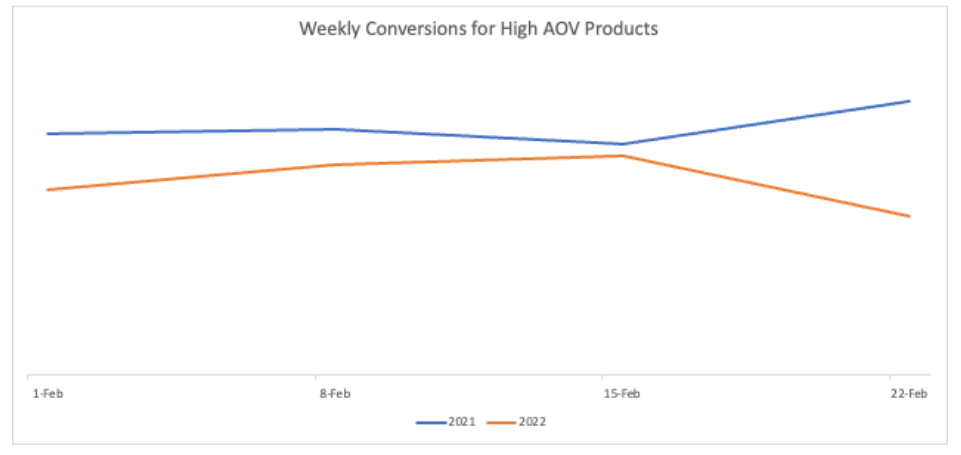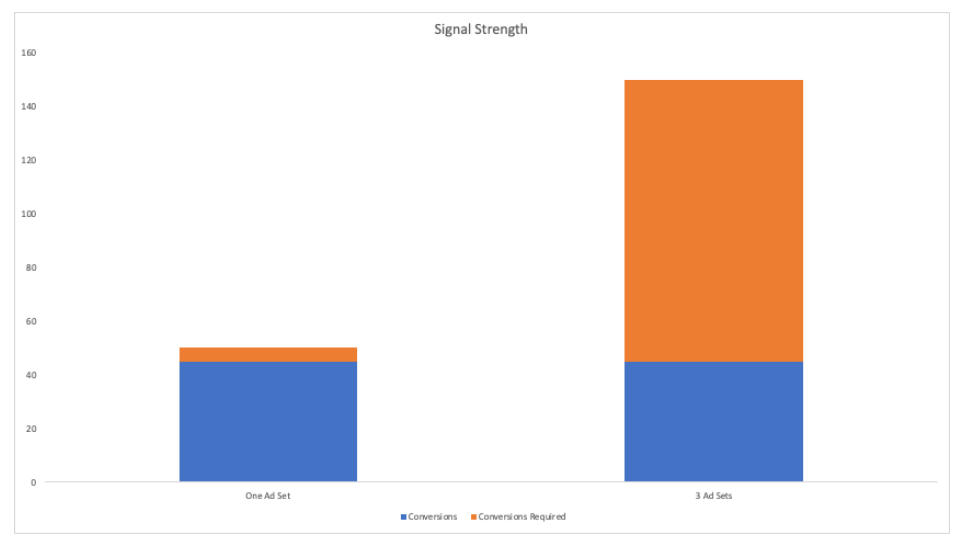But that’s only looking at the update on a comprehensive level. As it turns out, some advertisers are seeing significantly more negative impacts of iOS 14 than others. Especially brands with large average order values (AOV) are struggling more, leading to necessary strategic adjustments to maintain an efficient budget spend and maximize their efforts for ROI.
So, let’s dig in. We’ll start by outlining how advertisers with large AOVs are struggling since the iOS 14 update, before focusing on 5 strategies for Facebook advertising your brand can take should you find yourself in this position.
The Problem: Drops in Facebook Conversions for Brands with High AOV
It’s a problem more than a year in the making. According to research by Varos, weekly Facebook conversions for brands with average order values at or above $200 who invested more than $10,000 per month on Facebook dropped by about 35% in February 2022, when compared to February 2021.

- Conversion rate for these advertisers dropped at about 43%.
- CPM rates for these advertisers increased by about 29%.
Naturally, lower reach on the same budget combined with a lower conversion rate depressed conversions. Interestingly, though, click-through rates did not drop. Instead, they rose 23% year-over-year.
It’s difficult to find a more obvious cause than last year’s iOS 14 update for this. More users opting out of tracking means lowering signal, making it harder to find the right people to convert on your ads or website.
In some ways, volume acts as the great equalizer. Brands that sell hundreds of products on Facebook every day have seen a less significant impact on their conversions. But for advertisers with daily sales below triple digits, Facebook’s models have become less reliable.
Facebook’s Chief Operating Officer Sheryl Sandberg even confirmed this trend in Meta’s 2021 Q4 earnings call, when she discussed that iOS 14 challenges for advertisers are
“…easier to address this with large campaigns and harder with small campaigns, which means that part will take longer.”
So, the question moves to mitigation. How can brands with high AOV adapt, doing “more with less to improve their paid Facebook performance? In our campaigns over the past year, we’ve seen five steps work especially well in this environment:
- Consolidate Your Individual Campaigns
- Build Creative that Speaks to Broader Segments
- Forget About (Or Adjust) Your Retargeting Efforts
- Use DABA and Other Automated Ad Solutions
- Leverage On-Platform Signals For Better Data
Let’s explore each of these steps in more detail.
1. Consolidate Your Individual Campaigns
When it comes to Facebook ads, the conventional wisdom has been to build nuanced, specific targeting. That strategy allowed advertisers to speak to specific audience segments in more nuanced ways about their core interests and pain points, increasing sales volume, and lowering CPAs.
We generally use a conversion threshold of 50 per week for a campaign to be fully optimized. A strategy that depends on individual campaigns for specific audience segments becomes a problem when overall conversions are down.
For example, if your Facebook ads were resulting in 100 sales per week targeting men and women separately prior to the iOS 14 update, hitting that 50/week conversion threshold may no longer be possible. A 35% decrease in conversion might mean that both campaigns combined now only result in 65 conversions, or 33 per campaign. Each individual campaign is no longer fully optimized.
Consolidating your campaigns can get you back above that threshold. Now, a single campaign results in 65 conversions, allowing the overall campaign to be more fully optimized.
That’s not just a theoretical exercise. When we tested consolidating campaigns that had previously been separated by gender for one of our higher AOV brands, the results were significant. Simply consolidating genders drove a 24% decrease in CAC in this post-iOS 14 environment. If you get it right, consolidation works.
2. Build Creative That Speaks to Broader Audiences
A natural consequence of consolidating your campaigns, of course, is that your creative has to follow suit. In a pre-iOS 14 world, you might have been able to set up different audiences designed to reach more distinct segments and pockets within your larger target. For example, your testing may have shown different creative working better for different age brackets, allowing for increased customization.
Unfortunately, the necessary consolidation for brands with fewer conversions carrying higher values means this strategy is no longer effective. Ads have to be broader in focus, speaking to the broader audience your ad sets are now targeting.
Ads that may have previously targeted a specific gender now have to include gender-neutral messaging and visuals. Ads once customized for an age bracket should now work across your entire audience’s range. In short, any consolidation you make has to be followed through not just in targeting, but in your creative as well.
Gone are the days of higher AOV brands running two separate campaigns. Unless the baseline of weekly conversions supports it, there is simply not enough signal to make it work as effectively.
The good news: generalizing your creative can help to improve your conversions. In our consolidation experiment mentioned above, creating more general messaging and visuals further improved CPAs beyond the initial 24% reduction.
3. Forget About (or Adjust) Your Retargeting Efforts
This step might just be the most controversial recommendation in this guide to adjust to the new reality of iOS 14. After all, brands with high AOV tend to have a longer purchasing cycle, which makes retargeting a seemingly natural fit to keep your brand and product top of mind in the consideration stage.
Unfortunately, in our experience, real-life campaigns don’t back up that assumption. Let’s say, for example, that you’re getting 30 weekly conversions from prospecting, and 15 weekly conversions in your middle-of-funnel and bottom-of-funnel audiences post-iOS 15. Knowing that Facebook optimizes campaigns at the ad set level and knowing what we know about volume as outlined above wouldn’t those 15 conversions be better captured as part of your prospecting campaign?
Keep that 50/week conversion threshold in mind. With a single ad set, your 45 total weekly conversions are 90% to your weekly conversion goal. Multiply that threshold by three for three separate ad sets, and your 45 weekly conversions are less than one-third of the conversions you need for full optimization.

You might still be able to find a way to integrate retargeting into your overall paid strategy. If you are already getting enough optimized signal and want to reach net new audiences, you can include all MOFU and BOFU audiences from your prospecting campaign and set up a retargeting campaign specifically to audiences who need more than one ad.
But that’s only if your prospecting campaigns are already reaching their optimum signal, which–again–has become less likely post iOS 14. If you want to try it out for yourself, and your budget allows it, try split testing the impact of retargeting on your CPA against a campaign in which all funnel stages are consolidated into a single ad set.
4. Use DABA and Other Automated Ad Solutions
Facebook’s Dynamic Ads for Broad Audiences, or DABA, is a woefully underused self-optimization technique for brands who spend more than $10,000 monthly on the platform. Especially if you have a large enough product catalog, and your AOV is above average, we’ve found it to be the single most effective creative ad unit available today.
The basic concept behind this ad type is simple: Facebook learns about the products you sell based on web and app browsing activity, then leverages that information along with data it generates from other websites to predict which people might be most interested in your products. You can then promote each of your products with unique messaging, without having to create custom creative for each.
You might have heard about or even share the typical reservations about DABA, which is less control over your own creative and weaker creative than custom-created standalone ads. But don’t underestimate the potential effectiveness of this option for your conversion efforts.
DABA automatically shows the right products to users, increasing relevance for each specific users. Ads can show up as collections, carousel ads, or standalone assets, using video or static images. Copy options like “Free Shipping,” “Sale,” and “Popular” get inserted dynamically alongside basic product details.
Add it all together, and a product catalog with 50 products can result in more than 1,000 relevant creative permutations, automatically adjusted to most closely fit audience preferences.
DABA is not the only dynamic creative tool, either. Automated App Ads, for instance, allow app advertisers to run 50 assets in the same ad set dynamically. With less overall signal to test as much creative as was possible before iOS 14, automated tools like DABA and Automated App Ads become foundational components for high AOV products to maximize messaging relevance and succeed.

5. Leverage On-Platform Signals For Better Data
At this point, the impact of iOS 14 reducing Facebook’s off-platform signal is well known. It also means that Facebook advertisers need to gain more, higher-intent first-party signals to continue to reach more relevant users. Two ways are especially successful in help to accomplish that goal:
- Creating Instagram and Facebook Shops as a potential ad destination
- Using product tags on all of your ads.
Online storefronts on Facebook and Instagram are beginning to gain popularity for a reason. Facebook Shops now attract more than 250 million monthly visitors, driven at least partially by the platform’s desire to keep its users on platform. It’s only natural, then, for Facebook to offer the option to send traffic to your on-platform storefront instead of your .com website.

Tagging your products in either catalog or video and static ads is another effective tactic to ensure more relevant on-platform signal. As users interact with the tags on your ads, and visit your product pages on-platform or on your website, Facebook can gather relevant information to better catalog and optimize for audience behavior and intent.

The Post-iOS 14 Reality for High AOV Brands: Doing More With Less
After years of best practices that focused on more segmented, specialized, and targeted ads, many of the tactics discussed in this guide may seem counterintuitive. But, as platforms and user behavior continues to adapt to stricter privacy preferences, only brands that adopt their strategies alongside their audience’s preferences have a chance to continue succeeding.
In the world of iOS 14, and especially for brands with high AOV, that means doing more with less. More general ads and creative allow for better optimization possibilities, including the consolidation or even elimination of regargeting efforts. DABA and other automated solutions, which can dynamically create ad permutations based on user intent, as well as new strategies to leverage on-platform signals, can all help to push more signal through for products with lower conversion volume.
Almost a year into the change, we now have data to back up the strategies discussed in this post. As your brand continues to adapt to this new reality, doing more with less will remain a crucial consideration as you set up and optimize your campaigns over time.

